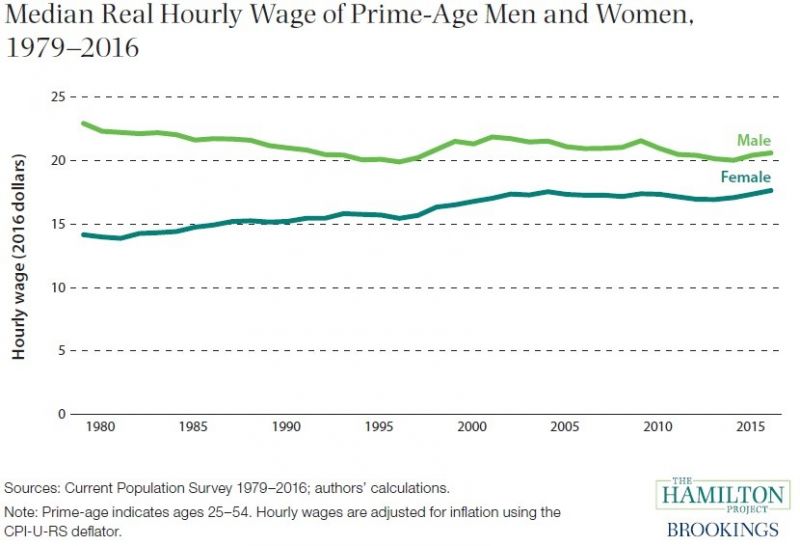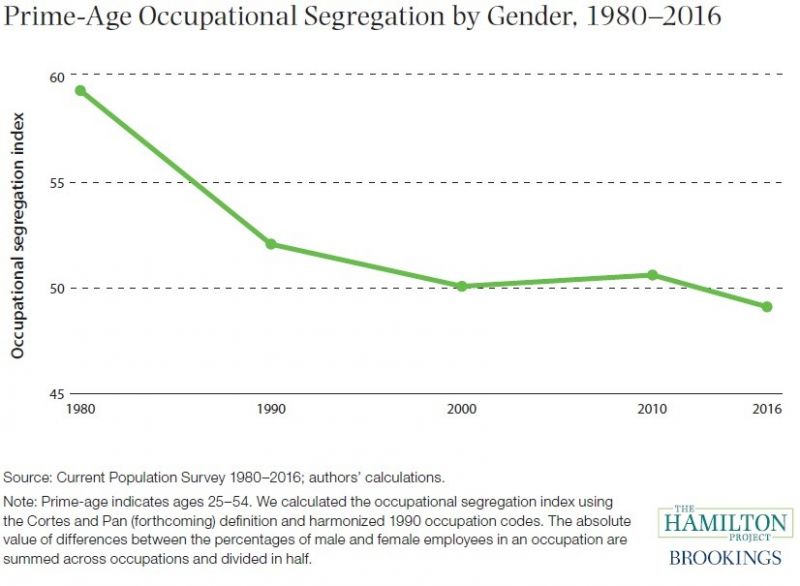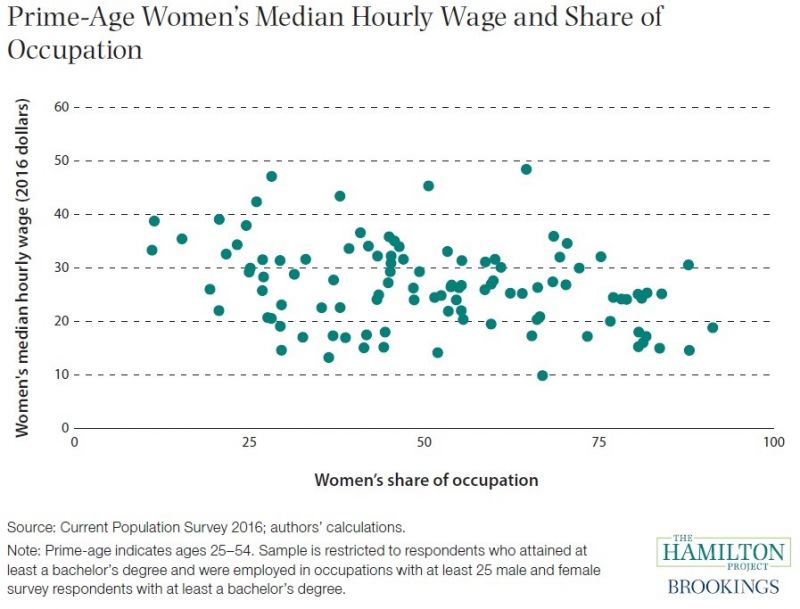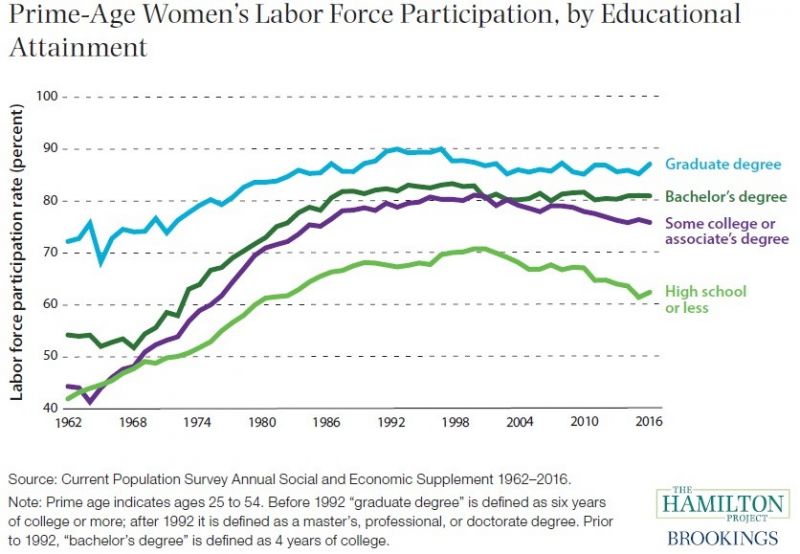Women and men often have very different labor market experiences. Women are paid less per hour, work fewer hours outside the home, and enter different occupations than men. These differing experiences in turn generate a host of other disparities, including lower levels of wealth, reduced retirement security, and more limited access to work-linked social safety net programs like unemployment insurance. Many of these disparities are examined and addressed in a book published last year by The Hamilton Project at Brookings—The 51%: Driving Growth through Women’s Economic Participation—from which the following analysis is also drawn. Improving women’s economic outcomes is not just important for them personally or their families, but a crucial part of a strategy to lift economic growth more broadly. We as a society cannot afford to squander the talents and skills of people who could be participating more fully in the economy.
One of the core differences between women’s and men’s labor market outcomes is the gender wage gap. The figure below gives a sense of how the hourly wage gap has evolved in recent decades for typical workers, showing that we have made substantial but incomplete progress in narrowing the gap. In inflation-adjusted terms, the difference between median hourly wages of men and women fell from about $9 per hour in 1979 to $3 per hour in 2016.

While this improvement is welcome, the continuing male wage advantage may be surprising in light of the strides women have made in educational attainment. After all, women became more likely than men to earn a bachelor’s degree all the way back in the mid-1990s, and more likely to earn a graduate degree in 2003. Given the strong wage premium commanded by postsecondary degrees, one might have expected the gender wage gap to decline more dramatically. Even after controlling for differences in age, race, education, and occupation, women now earn roughly 85 percent of what men earn.
A deeper examination of women and men’s labor market outcomes reveals another important way that gender disparities still manifest: the separation of men and women into different occupations. Women still tend to work in very different jobs than men, and occupational segregation has changed little over the last two decades, as shown in the figure below. This segregation, measured as the sum of the differences between percentages of men and women in each occupation, continues to hover near 50 percent, meaning occupations (weighted by employment) are on average 75/25 male or 75/25 female. While the lack of recent progress is not fully understood, we do know that occupational segregation is linked to a number of factors including the need for job flexibility, social norms, and labor market discrimination, among others.
 The separation of men and women into different occupations can have important implications for wages, given that women are disproportionately represented in lower-paid occupations. It is not entirely clear whether this is because women are excluded from high-paid professions or because once an occupation is dominated by women it becomes lower paid. Regardless, this segregation contributes to women earning less and may make it harder for some women to enter certain fields. For example, women make up only 14 percent of employed 25–54 year old electrical engineering majors, but have median earnings of $85,000 when they fall into this group. By contrast, women make up 96 percent of early childhood education majors and earn only $37,000 per year with that degree (see figure below).
The separation of men and women into different occupations can have important implications for wages, given that women are disproportionately represented in lower-paid occupations. It is not entirely clear whether this is because women are excluded from high-paid professions or because once an occupation is dominated by women it becomes lower paid. Regardless, this segregation contributes to women earning less and may make it harder for some women to enter certain fields. For example, women make up only 14 percent of employed 25–54 year old electrical engineering majors, but have median earnings of $85,000 when they fall into this group. By contrast, women make up 96 percent of early childhood education majors and earn only $37,000 per year with that degree (see figure below).
 Starting around 2000, 25–54 year old women’s labor force participation began to trend downwards. As shown in the figure below, this decline was most pronounced for those with a high school degree or less, whose participation fell from a peak of 71 percent to 62 percent in 2016. Weakening demand for low-skilled labor has played an important role in this development, just as it has with declining participation of low-skilled men. The U.S. experience of falling female labor force participation stands in contrast to outcomes in many other countries where prime-age women are working at a higher rate. U.S. women used to be more likely to participate in the labor force than those in other advanced economies, but now the U.S. is well below average in this regard.
Starting around 2000, 25–54 year old women’s labor force participation began to trend downwards. As shown in the figure below, this decline was most pronounced for those with a high school degree or less, whose participation fell from a peak of 71 percent to 62 percent in 2016. Weakening demand for low-skilled labor has played an important role in this development, just as it has with declining participation of low-skilled men. The U.S. experience of falling female labor force participation stands in contrast to outcomes in many other countries where prime-age women are working at a higher rate. U.S. women used to be more likely to participate in the labor force than those in other advanced economies, but now the U.S. is well below average in this regard.
 Understanding the gaps that remain between economic outcomes for women and men is crucial to finding the most effective policies that can enhance women’s opportunities. Improved policies related to child-care availability and affordability, individual taxation of married couples, pay transparency, and parental leave, among others, can all contribute to more robust and equitable women’s engagement in the labor force. Achieving this goal is an urgent macroeconomic concern: without the full and unfettered involvement of women in our labor force, economic growth will be unduly hampered, the benefits of growth will be unequally shared, and a great deal of human potential will be squandered.
Understanding the gaps that remain between economic outcomes for women and men is crucial to finding the most effective policies that can enhance women’s opportunities. Improved policies related to child-care availability and affordability, individual taxation of married couples, pay transparency, and parental leave, among others, can all contribute to more robust and equitable women’s engagement in the labor force. Achieving this goal is an urgent macroeconomic concern: without the full and unfettered involvement of women in our labor force, economic growth will be unduly hampered, the benefits of growth will be unequally shared, and a great deal of human potential will be squandered.

